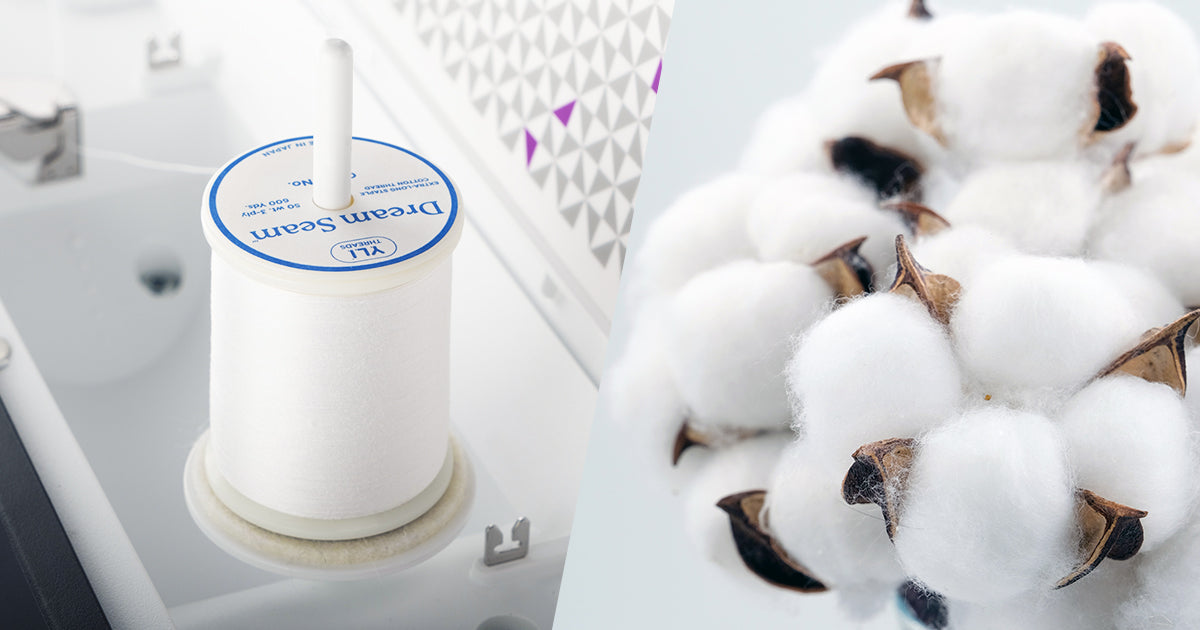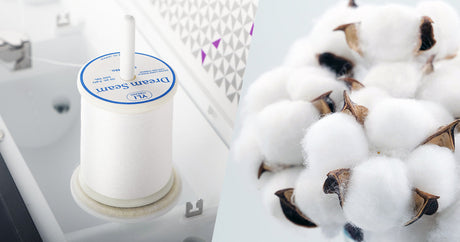The Key to Choosing the Right Cotton Thread for Quilting
A wise quilter once said, "Cotton threads are not created equal; just ask my machine if you want a second opinion." If you have experienced frayed, broken, or linty cotton threads when quilting or have spent hours at your machine cleaning the lint monster from under your needle plate, you'll most likely agree with her statement.
The difference separating low-quality cotton threads from high-quality cotton threads often comes down to one surprisingly simple detail: staple length. Understanding the differences between short, long, and extra-long staple cotton will help you choose the best cotton quilting thread for your projects, whether you're free-motion quilting on a longarm or piecing blocks on your favorite home sewing machine.
In this guide, we'll explain what staple length means, why it's important to understand the differences between short, long, and extra-long staple cotton thread, and how to select a thread that helps you achieve smoother, balanced stitches, cleaner seams, and a more enjoyable quilting experience.
How Long is a Cotton Staple?
When the word staple comes to mind, we think of the small, U-shaped metal wire that keeps stacks of papers together. Did you know that the small fibers from a cotton boll are also called staples, and that there are three different sizes, or categories, of staples referred to as staple length? Think of each fiber as being similar to a strand of hair, which can be short, medium, or long. The longer the fibers, the smoother and stronger the thread will be. Staple length directly affects the performance of cotton threads used for quilting and sewing. Staple length is categorized into three types: short staple, long staple, and extra-long staple.
Short Staple Cotton: Functional but Less Refined
Starting with the shortest length, we have short staple cotton. These fibers measure less than 1 1/8 inches in length. Cotton threads made from short staples are inexpensive, linty, and weak. The short length of these fibers requires more splicing to create a continuous thread. Imagine twisting the ends of a 1-inch strand together to create a 500-yard spool of thread. That's a significant amount of splicing during the manufacturing process. There is an association between the number of splices and the amount of lint a thread has. The greater the number of splices, the more linty it will be.
Characteristics of short-staple cotton thread include:
- Excess lint
- Visible fuzz and flyaways
- A slightly rougher feel in the thread
- Generally weaker, leading to more thread breaks
If the label of a cotton thread doesn't specify 'long staple' or 'extra-long staple', chances are it's a short staple thread.
Long Staple Cotton: A Step in the Right Direction
Long staple cotton fibers measure between 1 1/8 and 1 1/4 inches in length. The increased staple length results in a smoother, stronger thread than short staple, with reduced lint and fewer breaks.
We consider long staple cotton a good mid-range option for quilting thread because it offers an upgrade from short staple cotton threads in both the user experience and stitch quality. However, many quilters who try extra-long staple cotton thread find they prefer it, thanks to the noticeable improvement in stitch quality and machine cleanliness.

Majestic is our 40 wt. quilting thread made from 100% Egyptian-grown extra-long staple cotton
Extra-long Staple Cotton: The Cream of the Crop
Extra-long staple cotton fibers measure up to 2 inches in length. This increase from long staples' 1 1/4-inch-long fiber length (an extra three-quarters of an inch) surprisingly makes a substantial improvement in thread quality. A few traits that quilters love about extra-long staple cotton include:
- Smoother surface: These lengthy fibers are spun together in a more even manner, allowing the thread to flow more smoothly, so it glides through fabric and your machine with less resistance.
- Low lint: Fewer splices mean there is less lint buildup along the entire thread path, including tension discs, bobbin case, and beneath the needle plate.
- Increased strength: Due to the nature of the longer fibers, extra-long staple cotton thread resists breakage significantly more than short or long staple cotton, even under tight tension or high-speed longarm quilting.
If you want dependable performance when piecing and quilting with a cotton thread, extra-long staple cotton is worth every penny.
YLI Threads' Dream Seam is a 50 wt. 100% Egyptian-grown extra-long staple cotton thread, designed for seams that lie flat, making it perfect for piecing and quilting. For a more visible stitch with bold, variegated colors, Majestic is our 40 wt. 100% Egyptian-grown extra-long staple cotton thread that adds texture and depth to your quilting.
How Staple Length Impacts Your Quilting
For both home machine and longarm quilters, staple length directly influences stitch quality, machine performance, and the durability of your finished quilts and sewn projects. Longer fibers create a smoother, more uniform thread surface.
Extra-long staple cotton also sheds less lint, keeping your machine cleaner and running more efficiently. That means more time spent quilting and less time maintaining your machine. Because these fibers are stronger, they hold up beautifully under the demands of detailed quilting, stitching through multiple fabric layers, or tight tension settings.
Hand quilters notice these advantages even more. A smooth, strong thread glides effortlessly through the quilt sandwich, preventing tangling or fraying and making every stitch more enjoyable and precise. Learn more about what makes a high-quality cotton hand quilting thread.

A diagram representing the number of splices along a finished thread for each staple length.

High-quality cotton hand quilting threads are made from extra-long staple cotton and are treated with a glaze.
When piecing a quilt, a fine yet strong, extra-long staple cotton thread helps keep seams flat, with minimal presence or bulk, and maintains the fabric's natural drape and flexibility. Fifty weight threads (often written as 50 wt.) are the preferred choice for quilters when piecing blocks on a home machine. Using a thread that isn't too heavy but still strong enough to form secure stitches and keep the quilt together strikes the perfect balance.
For machine quilting on home or longarm machines, especially when you want your stitches to stand out, a 40 wt. extra-long staple cotton thread provides bold definition and a slightly more substantial presence on the quilt, showcasing the stitched design.
Hand quilters benefit from a glazed extra-long staple cotton, which resists tangling, knotting, and fraying, allowing it to easily glide through fabric layers.
Best Thread Weight For Quilting with Cotton
40 wt. cotton threads are a favorite among quilters because they are heavy (thick) enough to be visible, allowing for pure creativity to add texture and dimension to the quilt. However, there are times when 50 wt. cotton thread is a welcome choice. We enjoy using 50 wt. Cotton for piecing is preferred because it has a finer weight (it's thinner than a 40 wt. thread), allowing it to fit neatly between fabric layers. This helps keep seams flat and reduces their presence and bulk, ensuring your quilt top lies beautifully.
The fine (thin) nature of a 50 wt. cotton thread makes it an excellent choice for topstitching when you want your stitching to blend into the background rather than stand out.
Tips for Choosing Cotton Quilting Thread:
- High-quality cotton quilting threads, especially threads made from extra-long staples, have the highest tensile strength (resistance to breaking), the smoothest stitches, and a beautiful natural finish that complements cotton fabrics perfectly.
- Cotton threads work well in both home and longarm machines. You can use cotton for the top and bobbin at the same time or mix fiber types.
- Cotton staple lengths vary: short staples are less than 1 1/8 inches, long staples are 1 1/8 to 1 1/4 inches, and extra-long staples are up to 2 inches. Longer fibers produce smoother, stronger, and lower-lint threads.
Staple length may be small in measurement, but it has a big impact on your quilting experience. Upgrading to extra-long staple cotton quilting thread is a welcome improvement. You will enjoy smoother stitches, stronger seams, less lint, and a cleaner machine! Explore our full selection of cotton threads for quilting and discover how the right thread can transform your quilting experience from good to great.
About YLI's 40 wt. Majestic Quilting Thread
For machine quilting, our 40 wt. Majestic thread is genuinely exceptional. Made from 100% Egyptian-grown extra-long staple cotton, this thread is available in forty-five variegated colors and five solid colors. Bold and ready to enhance any quilt with eye-catching motifs, filigree, feathers, or edge-to-edge designs. Majestic is one of our premium cotton quilting threads, available in 2,000-yard cones and 600-yard spools.
Get inspired by Majestic colors








